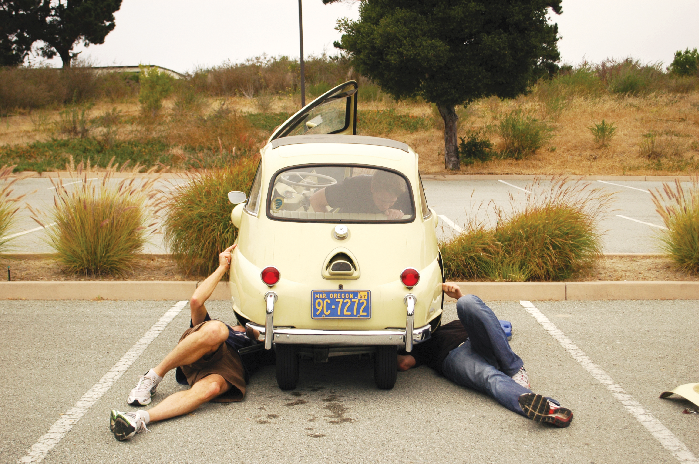
Going strong
This has been a good year for the collector-car market. Sales are up nearly everywhere, and expensive cars continue to get really expensive — and are being bought by collectors for whom “lots of money,” i.e., $10m or $20m, represents an avocational expenditure.
More than once in Monterey, I overhead someone saying something to the effect that, “Old cars are doing well; let’s put in $50m and buy a few.” Now, when they say “buy a few,” chances are they don’t mean picking up 1,000 1965 Mustang convertibles with pony interiors and the GT package.
Collectors of means seek out cars that tick all the boxes — rarity, beauty, mechanicals of note and historical significance. Having a good story helps. For example, two cars that fit that description were the 1936 Mercedes-Benz 540K at Gooding that made $11.8m, and the 1968 Ford GT40 that brought $11m at RM. There is no shortage of money for great cars.
What do auction prices mean?
We are often asked if auction prices are reflective of the market at large. There are two answers to this: From the range of $250,000 and above, the prices paid at auctions reflect a combination of market value and convenience. For a busy collector, having a selection of cars right in front of him can be worth a premium. They don’t often worry about paying too much — after all, there is an underbidder — but they do worry about buying a car that turns out to have bad stories.
They rely on the auction company to do research and present vetted kit, so that they are bidding with assurance. And the more assurances an auction company can provide, the more spirited the bidding is likely to be.
For cars under $250,000, catalog sales often provide an opportunity to “hit one over the fence,” rather than serving as a market indicator. The dream scenario of a Fiat Jolly owner is to have his car cross the block just after a $5m Ferrari, and to have two disgruntled bidders who didn’t get the Ferrari decide that they are each going to own the little beach car. The end result is a $25,000 car selling for $100,000. Four times market, but chump change for the buyer.
At catalog sales, most buyers of inexpensive cars are “buying down” — they are picking up four-wheeled baubles for one reason or another, and don’t care if they pay two or three times market. They like the toy, they want the toy, and they get the toy.
It’s not easy to get in on this “buying-down” bonanza. All the top catalog auction companies are oversubscribed with potential entries, and the less valuable a car is, the more brilliant an example it needs to be. Further, while each company is different, you can assume that if your car is worth less than $100,000, you will have to offer it at no reserve or the auction company simply won’t be interested. And finally, there is always the chance that all the buyers in the room who might want your 1969 Alfa Romeo 1750 GTV decide to visit the bidder’s bar just as your car crosses the block, and you end up with a retail price at best — before commissions, transportation to the auction and your own personal expenses.
All that nothwithstanding, if I were a betting man and looking to hit a long ball at a catalog auction sale, I would take a sexy, relatively inexpensive and easy-to-restore car, such as an MGA 1600 Mk II Deluxe roadster (only 313 built). Make sure it is presented in tasty colors (even if not original) and has flawless paint and fit, with an engine bay to die for. You won’t do worse than retail, and you just might ring the bell.
Next year
Barring some sort of global meltdown, we see the current market trends continuing to percolate along. Important cars will continue to soar in value, and we will see more of them at auctions as auctions continue to get big money for them.
Well-run vintage events will continue to grow in popularity, as our old cars become increasingly unsuited for driving in today’s conditions. Most vintage cars are increasingly cosseted and taken out for good times with like vehicles on friendly roads. They simply aren’t daily drivers any more, and they deserve to be enjoyed in a receptive environment. “What events can I do with it?” will continue to be an ever-more-important question when buying a car.
I’ve bought a lot of cars in the past couple of years, my goal being to sample the gamut of affordable sports cars from the tiny 1957 BMW Isetta to the sleek and stunning 2006 Lotus Elise. I have learned that clubs and events drive the ownership experience. If you are a newbie, look for cars that have robust clubs with lots of activities. Only buy a good car, from a good owner or a dealer who has a firm grasp on a car’s history. The cost of buying a bad car is both financial and emotional, as you write checks and at the same time wonder what caused you to make a profoundly stupid buying decision in the first place (see “red mist” in my files; I have a thick folder).
A good old car that has a variety of uses will enhance your life.
Changes
Mike Sheehan’s column, “Sheehan Speaks,” no longer appears in SCM. We have enjoyed a long and informative relationship with Mike and wish him well. Watch this space for announcements concerning what we have in store for you. We believe you will find it quite exciting. ♦